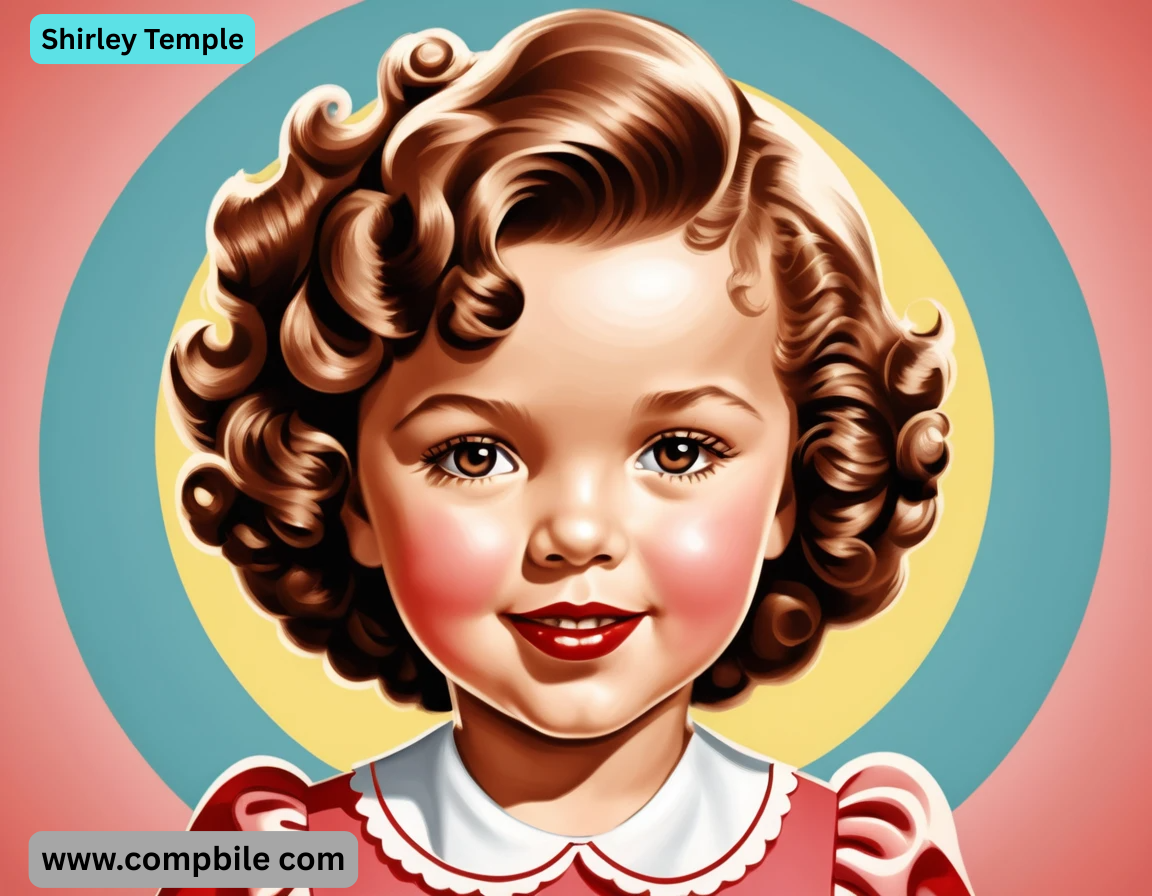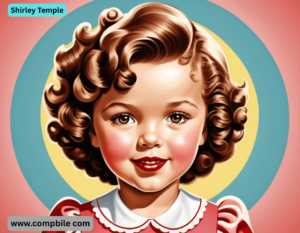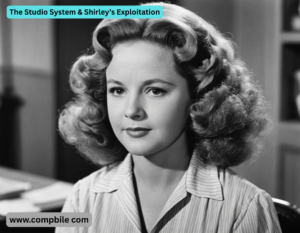Shirley Temple Shirley Temple (1928–2014) was an American actress, singer, dancer, and diplomat, best known as the most famous child star in Hollywood history. She began her career in the early 1930s and became a cultural icon, lifting spirits during the Great Depression with her cheerful performances.
Key Highlights of Her Career:
- Child Stardom – Shirley Temple rose to fame at just 6 years old with movies like Bright Eyes (1934), where she sang “On the Good Ship Lollipop.” Other notable films include Curly Top (1935), The Little Colonel (1935), and Heidi (1937).
- Box Office Sensation – She was the top box-office draw from 1935 to 1938, outselling adult stars.
- Signature Style – Known for her curly hair, dimples, and tap-dancing skills, she often played optimistic, precocious characters who brought people together.
- Transition to Adolescence – Her popularity waned as she grew older, though she continued acting into her teens in films like The Bachelor and the Bobby-SOXER (1947).
- Later Career & Diplomacy – After retiring from Hollywood in 1950, she entered politics, serving as a U.S. ambassador to Ghana (1974–76) and Czechoslovakia (1989–92).
Legacy:
- Academy Award – At just 6 years old, she received a special Juvenile Oscar in 1935.
- Cultural Impact – Her films remain classics, and she is remembered as a symbol of innocence and hope during difficult times.
- Postage Stamp – In 2014, the U.S.
Early Life & Discovery
- Birth: Shirley Jane Temple was born on April 23, 1928, in Santa Monica, California.
- Early Start: At just 3 years old, she began taking dance lessons at MEGLIN’s Dance School, where a talent scout from Educational Pictures (later 20th Century Fox) discovered her.
- First Short Films: She starred in a series of low-budget “Baby Bur LESKS” (1931–33), parodying adult films with child actors—a controversial concept today.
Rise to Superstardom (1934–1940)
- Shirley Temple became 20th Century Fox’s savior, single-handedly keeping the studio afloat during the Depression.
Iconic Films & Songs:
- “The Little Colonel” (1935) – Famous for her tap-dance sequence with Bill “Bojangles” Robinson, one of the first interracial dance partnerships on film.
Curly Top 1935 Sang Animal Crackers in My Soup
Box Office Dominance:
- By 1940, she had made 43 films and earned over $3 million (equivalent to ~$60 million today).
Awards & Honors:
- 1985: Honored with a Lifetime Achievement Award from the Screen Actors Guild.
Teen Years & Decline in Hollywood
- 1940s Transition: As she grew older, her child-star charm faded. Fox terminated her contract at 12 years old, and MGM later dropped her after “Kathleen” (1941) flopped.
- Retirement from Acting: Her last film was “A Kiss for Corliss” (1949). She later called her career “a kind of beautiful dream.”
Second Act: Diplomacy & Public Service
After retiring from Hollywood at 22, Shirley Temple reinvented herself:
- 1967: Ran for Congress (unsuccessfully) as a Republican in California.
- 1969–1970: U.S. delegate to the United Nations General Assembly.
- 1974–1976: U.S. Ambassador to Ghana under President Ford.
- 1989–1992: U.S. Ambassador to Czechoslovakia under President H.W.
- She was praised for her charm, intelligence, and dedication, proving her talents extended far beyond Hollywood.
Personal Life
Marriages:
- 1945–1949: John Agar (actor, divorced due to his alcoholism).
- 1950–2005: Charles Alden Black (businessman, happy marriage until his death).
- Children: Three (Linda, Charles Jr., and Lori).
Health Struggles:
- 1972: Diagnosed with breast cancer, one of the first prominent women to speak openly about her mastectomy.
- Died: February 10, 2014, at 85 from chronic obstructive pulmonary disease (COPD).
Legacy & Pop Culture
- The “Shirley Temple” Drink: A mocktail (ginger ale + grenadine + cherry) named after her (though she said she never liked it!).
- Dolls & Merchandise: One of the first stars to have a massive line of licensed products (dolls, dishes, clothing).
- Film Preservation: Many of her movies are preserved in the National Film Registry.
Quotes:
- “I stopped believing in Santa Claus at six when my mother took me to see him in a store and he asked for my autograph.”
Controversies & Criticisms
- “Baby Bur LESKS” – Some of her early films featured children in adult-themed parodies, now considered exploitative.
- Typecasting – Struggled to transition from child roles, later saying, “I was never allowed to be a child.”
- Political Criticism – Some questioned her diplomatic qualifications, though she proved effective in her roles.
The Studio System & Shirley’s Exploitation
- Fox’s “Cash Cow” – Studio head Darryl F. Zanuck tightly controlled her image, forcing her to:
- Wear 56 identical curls daily (maintained by a studio hairdresser using 28 pins).
- Work 12+ hours a day, with tutors on set to meet child labor laws.
- Perform even when sick—she once filmed with a 103°F fever.
- Salary Battles – Her mother, Gertrude, fought Fox for fair pay. Shirley earned $1,250/week at peak fame (≈$25k today), but Fox profited $50M+ from her films and merchandise.
- Emotional Toll – She later admitted, “I was a little trooper… but I didn’t have a real childhood.”
Breaking Racial Barriers
- Dancing with Bill “Bojangles” Robinson – Their tap duets in The Little Colonel (1935) and The Littlest Rebel (1935) were groundbreaking:
- One of Hollywood’s first positive interracial partnerships.
- Shirley credited him as her favorite co-star, but segregation laws forced them to use separate dressing rooms.
- Controversial Roles – Some films (Rebeca of Sunnybrook Farm) featured her in blackface minstrel scenes, reflecting era racism she later regretted.
The Dark Side of Child Stardom
- Kidnapping Threats – Fox hired bodyguards after she received death threats.
- Forced Adolescence – At 12, the studio padded her chest to keep her “little girl” image, then abruptly dropped her when puberty hit.
- Toxic Parents – Her mother controlled her earnings, while her father exploited her fame to promote his failed business ventures.
Post-Hollywood Reinvention
- TV Pioneer – Hosted The Shirley Temple Storybook (1958-61), adapting fairy tales.
- Business Ventures – Invested wisely in real estate and co-founded Shirley Temple Ltd., selling collectibles.
- Cancer Advocacy – After her 1972 mastectomy, she became one of the first celebrities to publicly discuss breast cancer, helping destigmatize it.
Psychological Legacy
- The “Shirley Temple Syndrome” – Psychologists use her case to study the effects of early fame:
- Pros: Resilience, adaptability, strong work ethic.
- Cons: Trust issues, difficulty forming peer relationships.
- Her Own Words: “Fame is a fleeting thing… I’m glad I had it early and got out.”
Lesser-Known Facts
- IQ of 155 – Tested in childhood, explaining her quick memorization of scripts.
- Secret FBI File – J. Edgar Hoover tracked her due to rumored communist ties (later debunked).
Where Are Her Oscars?
- Her Juvenile Oscar was stolen in a 1958 burglary.
- Her SAG Lifetime Award is displayed at the Shirley Temple Museum in Santa Monica.
Final Years & Death
- Last Public Appearance: 2012 – Received the Life Achievement Award from the Screen Actors Guild.
Get article on pdf file….Click now
…..Shirley Temple……




